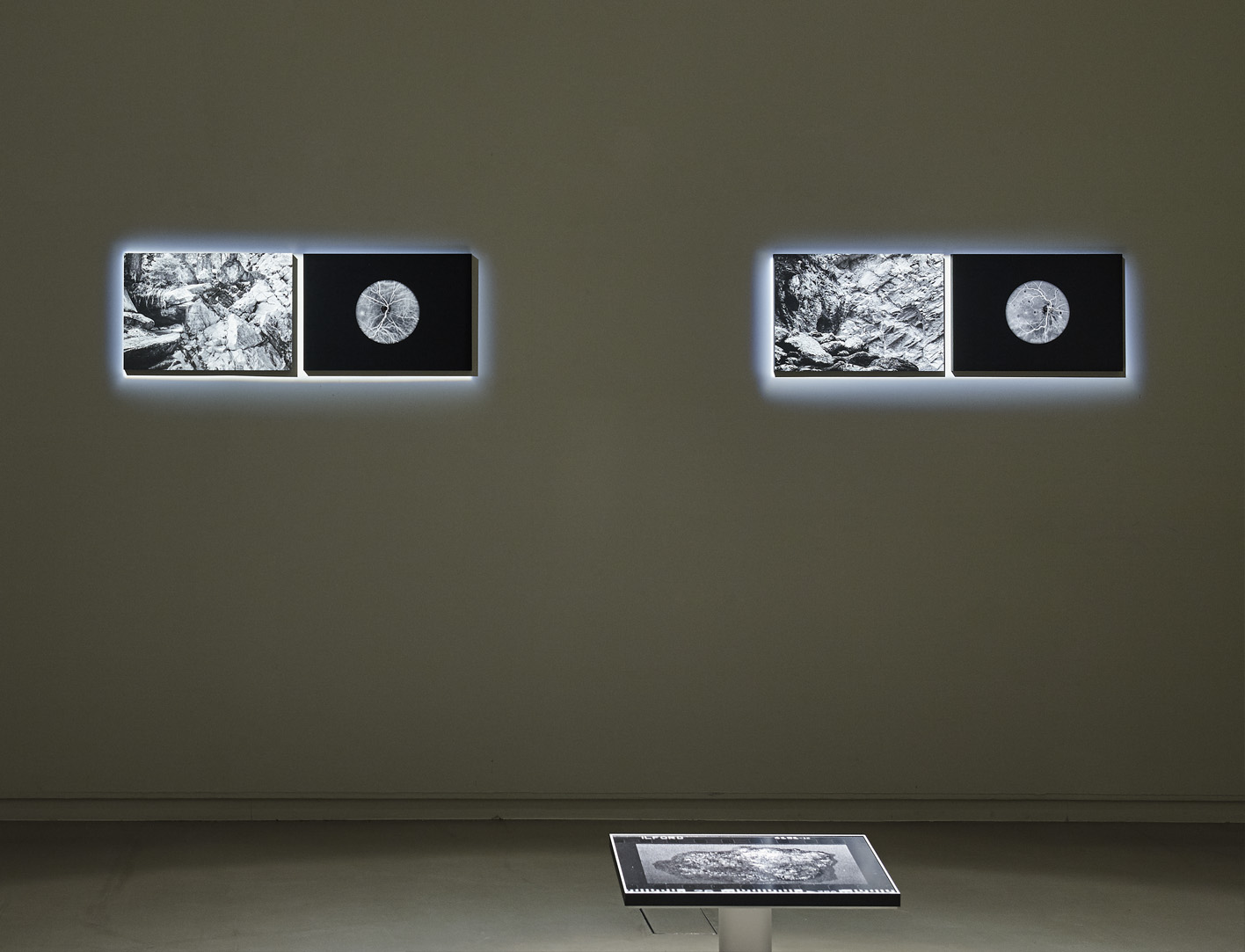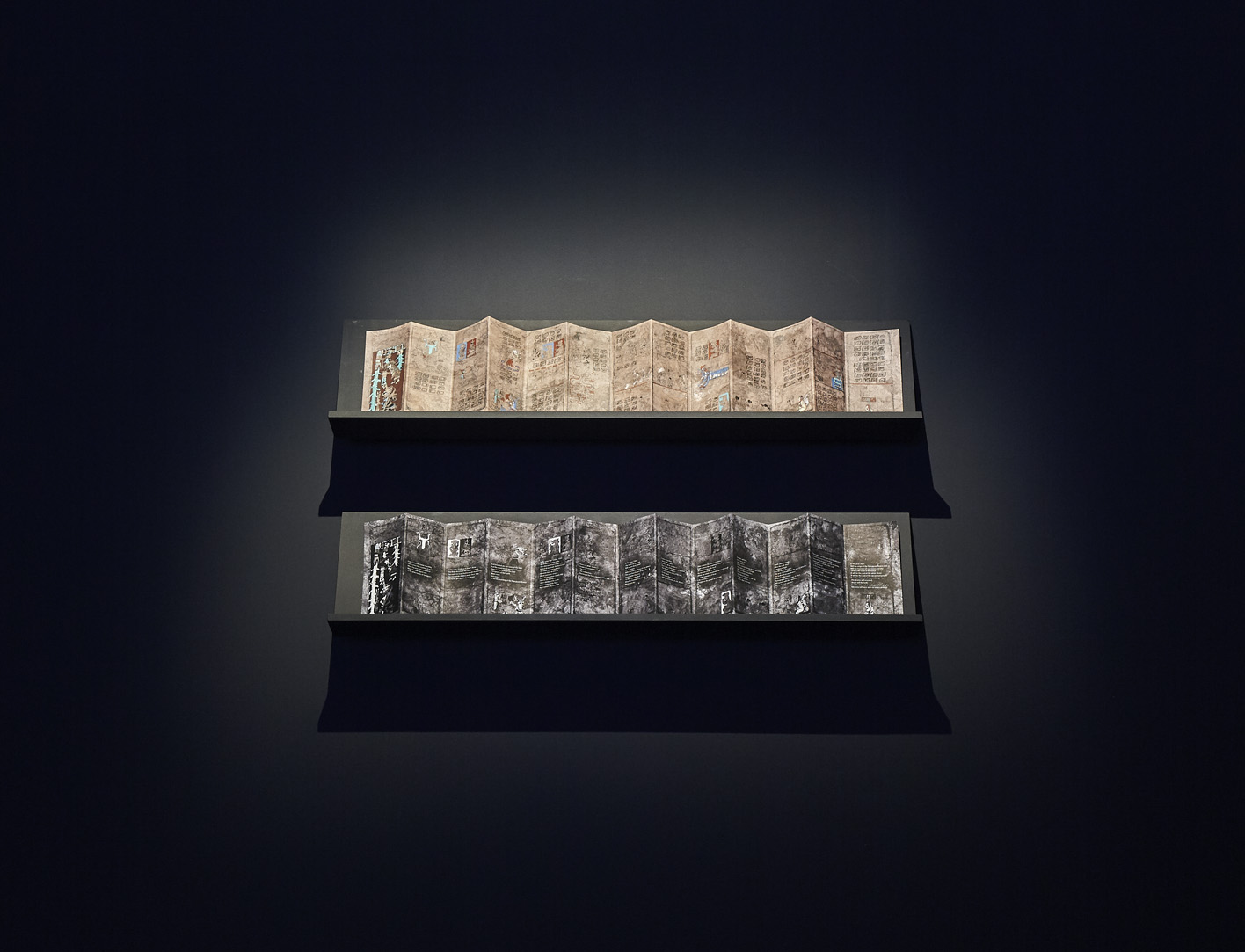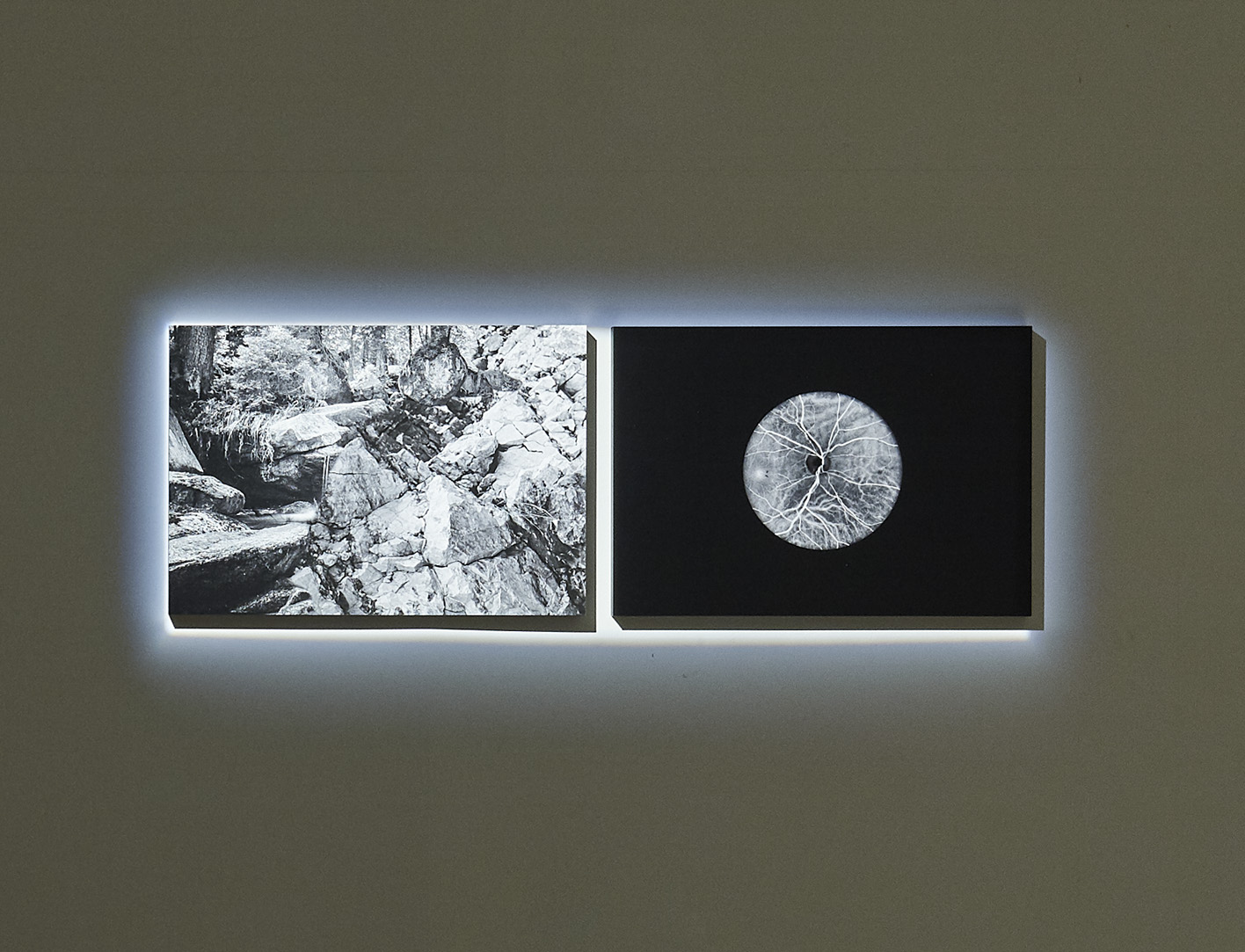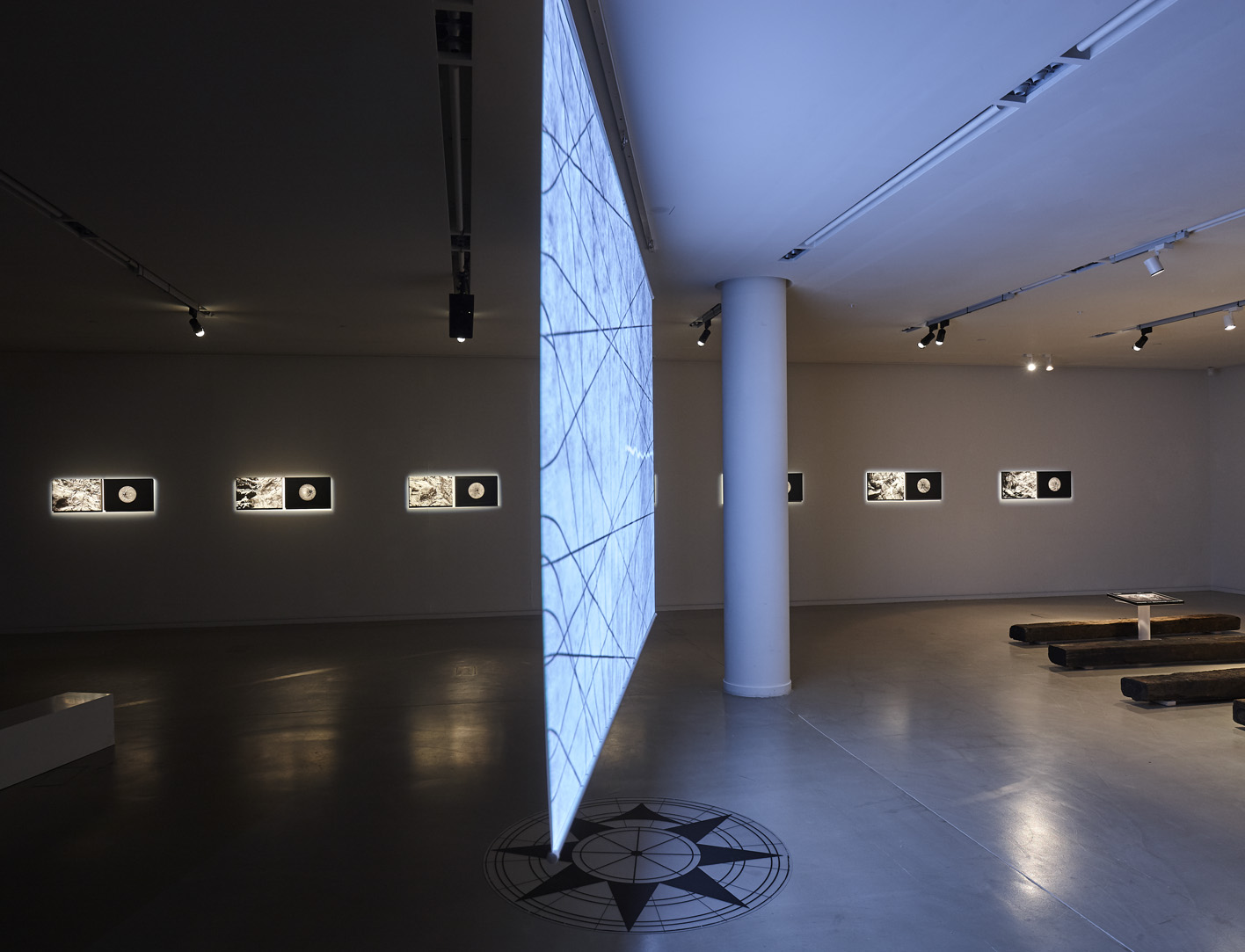













Silver memories : how to reach the origin, 2019
Exposition à l’atelier Hermès, Séoul
Production Fondation Hermès
Photo Kiyong NAM © Fondation d’entreprise Hermès
Silver memories : how to reach the origin, 2019
Exhbition at Atelier Hermès, Seoul
Produced by Fondation Hermès
Photo Kiyong NAM © Fondation d’entreprise Hermès
Exposition à l’atelier Hermès, Séoul
Production Fondation Hermès
Photo Kiyong NAM © Fondation d’entreprise Hermès
Silver memories : how to reach the origin, 2019
Exhbition at Atelier Hermès, Seoul
Produced by Fondation Hermès
Photo Kiyong NAM © Fondation d’entreprise Hermès
Au début de l’exposition, chaque tirage est posé sur un lutrin à 30 cm du sol.
Une douzaine de poutres au sol, espacées chacune de 70 cm environ.
Bande son (bruit de torrent et de déclencheur d’appareil photo).
Le spectateur est convié à s’imaginer en orpailleur, non pas tenant un tamis au-dessus d’une rivière, mais penché sur des images, y cherchant des grains d’halogénure d’argent. Contrairement à l’or, la recherche d’argent se fait dans les mines et non dans les rivières. Mais cette pièce me permet de suggérer au spectateur l’attitude physique du corps portant le regard et sa quête au travers l’image.
L’écran vidéo est installé au centre de la salle. Le spectateur est invité à passer d’un côté à l’autre pour découvrir les différentes parties de la vidéo. L’orientation de l’écran suit l’axe Est/Ouest de la salle.
At the beginning of the exhbition, every print is set on a lectern at 30cm above the ground.
A dozen beams on the floor, about 70cm apart
Soundrack (a mountain stream and the sound of a camera’s shutter release)
Viewers are invited to imagine themselves as gold panners, not holding a sieve in a river but rather looking for silver halide grains in pictures. You don’t look for silver in rivers anyway, it’s the product of a mining process. However, with this piece, I suggest to the viewer’s mind the physical stance of the body when pushing one’s visual quest beyond image.
The video screen is set up in the middle of the space. The audience is invited to go from one side to each other to watch the different parts of the video. The position of the screen follows the Est/West axis of the space.
_
Nous pourrions faire face à la disparition du métal argent qui - comme d’autres ressources minières - se tarirait au cours du 21e siècle. Selon Mansoor Barati, spécialiste des métaux rares et de leur recyclage à l’Université de Toronto, le minerai argent serait épuisé aux alentours de 2029.
Si la moitié des stocks mondiaux d’argent est dévolue à la fabrication de bijoux et de pièces de monnaie, l’autre moitié est dédiée aux applications industrielles du métal (électronique, antiseptique, panneaux solaires, etc). Parmi elles, on peut également citer les films argentiques, constitués d’une couche de cristaux d’halogénure d’argent, réagissant à la lumière pendant son exposition et venant former l’image.
Cette information nous invite à penser différemment la photographie argentique : non plus seulement image mais aussi objet, envisagé à la mesure de sa matière première.
Et si nous regardions au-delà de la naissance de la photographie qu’on date au 19e en Europe ? Et si nous pensions l’origine de la photographie avec la découverte des Amériques et l’exploitation de ses mines d’or et d’argent ? L’afflux considérable de ce métal précieux dans le vieux continent - qui possédait déjà ses propres mines d’argent - a marqué durablement l’économie européenne et a permis par la suite ses utilisations industrielles.
Silver memories : how to reach the origin est un projet composé de plusieurs séries photographiques et d’une vidéo. Peu à peu, les différents travaux invitent le spectateur à devenir un orpailleur, à chercher dans les images photographiques non pas l’or mais les grains d’halogénure d’argent.
Repérer la matière première derrière la représentation, c’est non seulement envisager nos images dans le lointain écho d’une économie mais aussi questionner la façon dont le regard circule à la surface de ces matérialités.
Silver metal could soon disappear, since its point of exhaustion is bound to occur during the 21st century, just like it would happen with other mining resources. According to Mansoor Barati, an expert on rare metals and their recycling from the University of Toronto, it would become impossible to find silver ore to extract by 2029. While half of the world’s silver stocks is intended for the manufacturing of jewels and coins, the other half is used in industrial applications (electronics, antiseptics, solar panels, etc). Silver halide films, made up of a thin layer of silver halide crystals, fall into this category : their reaction to light ultimately leads to the formation of the image on a photography.
This observation is in itself an invitation to adopt a different approach to analogue photography, not only from the standpoint of the image produced, but also as an object derived from a raw material. What if we went further back than the invention of photography in 19th century Europe ? What if we considered the very origin of photography, going back to the discovery of the Americas and the mining of its gold and silver resources ? Although there also were silver mines in the Old World, the inflow of silver from that time on was so considerable that it had durable impact on Europe’s economy, which then led to its vast industrial applications.
Silver memories : how to reach the origin is a project that consists of several photographic series and one video. A number of works aim at gradually turning the viewer into a gold panner, looking into photographic images not for gold but for silver halide grains.
Detecting the raw material behind the simulacrum lets you not only consider our pictures as remote echoes of a whole economic system, but also ques-tion the way the eye shifts along the surface of those materialities.